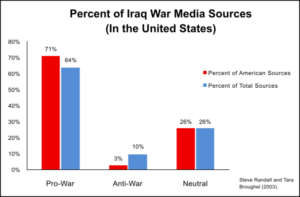
Post-truth, or post-irony?
“What is truth?” said Pontius Pilate to Jesus. Or at least this is what we are told he said in the Gospel of John. Can we trust John to have related accurately the words of Pontius Pilate? Most scholars date the book of John as two generations after Pilate’s death. And yet, despite the dubious provenance of the quote, it is a very important question. Indeed it is the central question we concern ourselves with here.
On November 24, 2016 the Washington Post ran a story entitled: “Russian propaganda effort helped spread ‘fake news’ during election, experts say”. The article claimed that Russia had been involved in a concerted effort to sway the election in favour of Trump through a sophisticated propaganda war. But perhaps even more significant than the central claim, is that it launched the phrase “fake news” into the media discourse.
The story drew heavily from a think-tank known as PropOrNot who supplied a list of 200 websites that “wittingly or unwittingly” were “reliably” party to a Russian propaganda offensive. The list covers websites of both a left-wing and right-wing persuasion. Some of them are overtly associated with fascists (dailystormer.com) or white power movements (vdare.com). Some of the sources, such as infowars.com are famously unreliable, mixing nonsense with kernels of truth so regularly that asking the information content would be akin to asking for the nutrition content of corn-studded faeces. However, some of the sites, such as AlterNet.org or AntiWar.com provide relatively reliable information. And some, such as Films for Action are very hard to see as being in any putative Russian camp.
Not long after the release of this news article, an exquisite dramatic irony began to unfold. Attempts to check up on the story began running into difficulties. The PropOrNot think-tank which featured prominently in the article, was revealed as peculiarly shadowy. When pressed in phone conversations, the lone contact for the organisation declined to state the methodology by which they had determined this list of websites to be “fake news”. How Russia was the lead in this constellation of sites, or how it could be shown that they were reliably in the Russian camp was entirely absent. In addition, the organisation had no address, no list of employees and no donors list.
How could the Washington Post have used this totally opaque and previously unknown think tank as its primary source? Further investigations by Mark Ames uncovered disturbing connections with Ukrainian fascists and the US security state. The news story had begun to unravel. The story was one as propagandistic, and directed for effect by geopolitical actors, as any fake news story to which it was supposed to be drawing attention. Amazingly, the seminal news story on “fake news”, turned out to be “fake news” itself. And to complete the irony, the media outlet which published the story by Mark Ames, was one of those listed by PropOrNot as “fake news”.
The complexity of navigating news derives from the fact that the world of media is composed of actors, with agendas they would like to sell, as well as advertisers to whom they would like to sell us. “Fake news”, as a moniker, is designed for a specific effect, and that effect is to persuade.
The most common approach to the interpretation of news, is, as is often the case, one of the simplest. We simply divide sources into those which are trusted, and those that are not. And this is the approach which PropOrNot is attempting to leverage. By telling us which sources we should not use, they suggest by contrast that the other sources: the New York Times, the Washington Post, The Guardian, are to be relied upon.
This approach presents itself as drawing our attention to disinformation; it implicitly or explicitly poses as not “fake news”, or “true news” while it does so. The stakes are exceedingly high, as the beliefs of the greater population are no small matter. It is the difference between who can rule, under what conditions and how.

This simplistic model can be inverted in any number of different ways, simply by choosing a different ‘a priori’ set of excluded sources and trusted sources. While habitual readers of the New York Times might feel quite content with the quality of their source, the same can be said of those who read only from ‘prisonplanet.com’ or ‘infowars.com’. They live in a world ‘through the looking glass’ in which anyone who reads the New York Times is a sheeple reading propaganda produced by globalists.
So how do we read or watch the media? Do we give up on knowing, or is it possible for us to “read between the lines”, so to speak? We can’t very well proceed with any sort of agency in a world in which we are completely blind. We need some way to navigate the rocky shoals of misinformation, disinformation and propaganda.
Karl Popper, the famous philosopher, developed a theory of scientific inquiry. In his systematisation of science, we would first build a model. This model then would make predictions. If the predictions turned out to be false, according to the measured data, we would reject the model.
Unfortunately this approach is too strong, even when our inputs can be trusted. All models are simplifications of reality, and therefore do not capture the full richness of it. They are all in some sense “wrong”. That some data points are not correctly predicted is insufficient cause to reject a model if it works well most of the time.
Popper’s student, Imre Lakatos, described a more pragmatic approach to modeling that is closer to what is actually employed by scientists, which took this need to allow some divergence from theory into a account. The idea is to have a model which captures a good deal of useful properties that we see in the data, and we can provide patches for information that does not fit. When a model is mostly patches, Lakatos would describe it as degenerate.
And yet even Lakatos’ theory of programmes still falls short when applied to news. The situation with news is even more difficult than the problem that the philosophers of science were trying to solve. The data points that we obtain are themselves suspect and not just because of incorrect “measurement” or noise. We can’t trust that they are correct because those relaying the information are attempting to persuade us of a particular belief.
Sifting through this information then means creating a model, not just of the world which accords with the information we receive, but also a model of what it means when certain actors present certain information. Establishing this ‘underlying meaning’ requires a theory which ascribes motive to these actors and allows us to read the subliminal semantics. Thus we enter into the realm of the Hermeneutics of Suspicion.
This may all sound very baroque, but a basic theory of suspicious interpretation is widely practiced, and is sometimes called ‘qui bono’ or ‘Who benefits’? Most people understand the fact that advertisers are not trying to inform us and instead are attempting to obtain profits from commodity sales. Therefore their claims are taken with skepticism. Similarly most people recognise that media organisations require advertisers, and that upsetting their main advertisers could cost them dearly and so whatever ethical benefit there may be in the full disclosure of information which might cause harm to an advertiser, the media organisation may be disinclined to partake.
Perhaps a concrete example of suspicion might be of use. During the second Iraq War, we were told of weapons of mass destruction in Iraq. About half of Americans believe that there were in fact weapons of mass destruction before the war. About one third believe that not only did they not exist, but that the public was deliberately mislead. After the occupation, no evidence whatsoever has been provided which would corroborate the existence of weapons of mass destruction, so it is fairly easy to establish that approximately half of Americans are simply ignorant of the reality. However the case for deliberate disinformation is much more difficult to establish, but suffice it to say, my cynicism lead me to fall into this suspicious camp.
Among the suspicious camp, it was widely believed (both before and after the war) that Cheney et al. were interested in oil resources and war profiteering as their primary goal in conflict. This is again, a simple application of ‘qui bono’. This was, indeed, my own model, and was reflected in me chanting along enthusiastically to the slogan “No blood for oil!” at marches.
I still belong to the camp of the suspicious, but my model has changed. The primary motives in the Iraq conflict were the projection of geopolitical power, the dismantling of a semi-autonomous or non-compliant regimes, and the creation of a territory which could serve as a node for further projections of power in the Middle East. One might call this altered model of motive, a theory of ‘imperialism’. The ‘stealing black gold’ thesis suffers from the problem that a number of wars which were fought between the US and allies with oil producing states, but subsequently oil production proved difficult to impossible due to instabilities. Further, the costs of these interventions far exceeds any direct costs which could be covered by the oil. It is more likely that the non-compliance of the states is related to the relative autonomy provided to their economies due to their control of oil, reducing their fears of sanctions or trade wars.
 The news media, including Fox News, CNN, MSNBC, the New York Times, and the Washington Post, all dutifully reported the narrative given by the government during the Iraq war. As a rule, they apply little to no skepticism of the motivations or intentions of the US government or its close allies. Noam Chomsky has for decades collected evidence that this behaviour is systematic. He also proposes the mechanisms and pressures under which this takes place with his theory of the manufacture of consent. This model of suspicion incorporates many of the features required of a model which takes into account the social relations which help to produce effective narratives, namely: incentive, capacity and coercion. Other related approaches used in investigate systematic influence in the Irish context of media surrounding the Irish property market, can be found here and here.
The news media, including Fox News, CNN, MSNBC, the New York Times, and the Washington Post, all dutifully reported the narrative given by the government during the Iraq war. As a rule, they apply little to no skepticism of the motivations or intentions of the US government or its close allies. Noam Chomsky has for decades collected evidence that this behaviour is systematic. He also proposes the mechanisms and pressures under which this takes place with his theory of the manufacture of consent. This model of suspicion incorporates many of the features required of a model which takes into account the social relations which help to produce effective narratives, namely: incentive, capacity and coercion. Other related approaches used in investigate systematic influence in the Irish context of media surrounding the Irish property market, can be found here and here.
These theories give us information about plausible motives. In turn this enables us to qualify our degree of belief in a source within a specific domain. For instance, while most educated liberals in the United States would currently reject RT news as a source of any value, it was a very good source of information on the bank bailout in the US. When applied to events within Russia itself, or within its sphere of influence, its bias can become more obviously a deterrent to clarity. This makes sense within a framework which incorporates motive, information which can be corroborated and can harm the legitimacy of a geopolitical opponents ruling elite, is more useful than mere disinformation, which is more readily challenged.
Though one might take issue with this or that theory, theories of suspicion are not merely optional approaches with which we can dispense. Accepting all sources as simultaneously true quickly leads almost immediately to inconsistency. Some, such as Gavin Titley, have rejected the apparatus of theory as a lens of suspicion, or at least its suitability for students. Yet filters must be applied, either using the most basic trusted-untrusted dichotomy, or some other more sophisticated approach to modelling the motives of actors in the realm of information conveyance.
Suspicion itself is, however, philosophically complex and problematic. A model of suspicion allows you to reject data-points which might prove inconvenient. They may be the very data-points which invalidate or inform the model of suspicion. This phenomena is known as ‘epistemic closure’. The sensitivity of truth to the rejection of contradictory information is present in many of the seemingly unresolvable political debates that play out. They appear unresolvable because the different groups reject the evidence base from which the other is working to inform their understanding.
We should seek to choose a model which grounds itself in a broader framework which can act as a scaffold from the outside and which is subsequently less sensitive to the information which we are treating skeptically. That is, our deductions should proceed from a different base of knowledge than the knowledge being evaluated. We should produce models of social relations and materiality which are robust in a range of experimental regimes.
Suspicion of the mainstream media is widespread, and growing. Within a Marxist framework we might say that this results from contradictions. These contradictions arise between the narrative that is provided by the media and the counterposed direct experience of those whom they are trying to persuade. While the media may have significant impact in persuasion of events which are far-away and difficult to interpret, when the audience themselves have their own more direct observations, these narratives can quickly become less effective. Economic tensions can often stretch media narratives which hope to keep social peace to the breaking point.
These contradictions breed suspicion, and yet suspicion need not be structured by any coherent argument. There are many who believe in quite improbable conspiracy theories, such as the two men I overheard talking quite seriously about the lizard people who populate the elite earlier today on the street. Suspicion can drift into undirected conspiracism, and perhaps ironically, into credulity of ‘alternative’ sources. One might conjecture that the more absurd the mainstream news is with respect to lived experience, the more conspiracist in interpretation the population is likely to become.
There are no easy solutions to our conundrum which are also liable to be robust. And in the absence of easy solutions, we can expect that most approaches which are applied in practice will range from the inadequate to the absurd. In the end it may be that that truth itself is less important than the trust-networks we form and how they are structured and their impact on our organisational abilities. Religion proved quite organisationally capable over millennia while simultaneously conferring beliefs of one God in three Divine Persons and the virgin birth. Perhaps, in the final analysis what we really need is to start looking at what materiality could form a media and associated trust networks from a perspective that supports our bias, the bias of the labouring class. In the words of Antonio Gramsci:
It is absurd to think of purely “objective” prediction. Anyone who makes a prediction has in fact a programme for whose victory he is working, and his prediction is precisely an element contributing to that victory … Only the man who wills something strongly can identify the elements which are necessary for realisation of his will … predictions made by people who claim to be impartial … are full of idle speculation, trivial detail and elegant conjectures.










